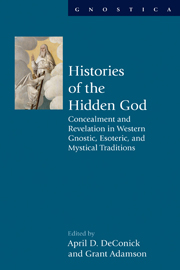 Histories of the Hidden God
Histories of the Hidden God The quest for the hidden god in Judaism, Christianity, and Islam is as old as the blending of philosophical and religious perspectives in the ancient Mediterranean. This volume on Histories of the Hidden God impressively shows that the dialectic of concealment and revelation of divine secrets has been an influential structural characteristic of Western religious tradition. Knowledge about the nature of the divine has always been linked to dangers and risks – but the higher the risk, the higher the prospective reward, one might say. Among the perceived dangers was the transgressive potential of this knowledge that ultimately put the human being in the position of the god. This was at the same time an important promise for the seekers themselves, along with the promise of salvation through gnosis.
It would be a futile attempt to provide a response to the many chapters of this volume. With its broad spectrum of approaches, topics and contents, esotericism, and mysticism in Western culture; however, it also reveals the difficulty of finding a coherent analytical framework for scholarly interpretation. How can we differentiate Gnostic, esoteric, and mystical currents? How do these currents become “-isms”? And what is gained by constructing such “-isms” in scholarly discussion? Do these terms help us explaining cultural dynamics, and if so, what kind of dynamics are we dealing with?
To save this book to your Kindle, first ensure [email protected] is added to your Approved Personal Document E-mail List under your Personal Document Settings on the Manage Your Content and Devices page of your Amazon account. Then enter the ‘name’ part of your Kindle email address below. Find out more about saving to your Kindle.
Note you can select to save to either the @free.kindle.com or @kindle.com variations. ‘@free.kindle.com’ emails are free but can only be saved to your device when it is connected to wi-fi. ‘@kindle.com’ emails can be delivered even when you are not connected to wi-fi, but note that service fees apply.
Find out more about the Kindle Personal Document Service.
To save content items to your account, please confirm that you agree to abide by our usage policies. If this is the first time you use this feature, you will be asked to authorise Cambridge Core to connect with your account. Find out more about saving content to Dropbox.
To save content items to your account, please confirm that you agree to abide by our usage policies. If this is the first time you use this feature, you will be asked to authorise Cambridge Core to connect with your account. Find out more about saving content to Google Drive.